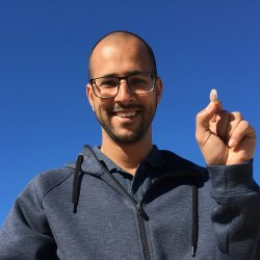 /
/The Riley Scholars-in-Residence Program is proud to announce Dr. Solomon Seyum, postdoctoral Riley Scholar-in-Residence in Geology, extended his collaborative research with Charlie Robinson (Geology '21) and Cade Quigley (Geology '22) to include the students' attendance at the "Teaching Quantitative Structural Geology" workshop hosted by Professors Emeriti David D. Pollard (Dr. Seyum's Ph.D. advisor) and Stephen J. Martel during the Geological Society of America conference last month.
The workshop, based on Pollard and Martel's Structural Geology: A Quantitative Introduction, focused on "three topics that typify a new approach to teaching structural geology at the undergraduate level using quantitative methods and taking advantage of modern computational and visualization tools." To address the ways "structural data usually span regions of heterogeneous deformation," Drs. Pollard and Martel "consider physical fields that vary in space and time, governed by equations of motion with suitable boundary conditions and constitive properties," also introducing "canonical problems for the major types of geologic structures, including fractures, faults, folds, fabrics, and intrusions" and bridging "the gap between traditional techniques of descriptive geometry and modern techniques of differential geometry, using vectors and 3D visualization with MatLab to reach students who have difficulty thinking in 3D."
About his experience, Charlie noted, "I learned about the importance of quantitative methods and their place in structural geology. In an ever-changing field, the need for quantitative explanations is paramount to solving complex problems, and the workshop was an opportunity for me to burst out of the Colorado College bubble and become more familiar with the world of geosciences. Additionally, it provided more depth to my understanding of the foundational concepts of continuum mechanics from a geological standpoint, which gives me a more complete and holistic understanding of the work I am engaged in with Professor Seyum."
Similarly, Cade explained, "This short course was very intriguing, because it connected the geologic structures us geologists ponder over to the basic, fundamental laws of physics. It is something I hadn't fully grasped or appreciated until then. Additionally, this is extremely applicable to the work I'm doing with Professor Seyum, which makes it easy to get excited and start jumping all over the place with ideas to explain the geology of our region, continent, and the world! Thankfully, physical laws remind us that everything happens for a reason, and we must be quantitative in our approach to finding that reason."
Thank you, Dr. Seyum, for continuing to find creative and engaging ways to excite students about collaborative research! We are so proud to know you!


